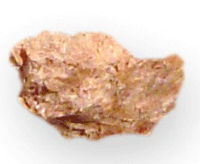Difference Between Zinc White and Titanium White
• Categorized under Science | Difference Between Zinc White and Titanium White

Zinc White, or Zinc Oxide (ZnO) is an organic compound, and is often used as an additive to various materials, such as paint, adhesives, lubricants, and food. Titanium White can also be referred to as Titanium Dioxide (TiO2), and is mostly used as a white pigment for a variety of applications.
Titanium White has an extremely solid and brilliant white appearance. It has a high refracting index and tinting strength. This is the reason why it is commonly used for white paints. Zinc White, on the other hand, has only one-tenth of the tinting strength of Titanium White, and its appearance is more translucent, and less brilliantly white.
Any color mixed with Titanium White is immediately changed to a much lighter shade. Although this can be the effect desired, it can also be too over-bearing in some occasions, as its whiteness is clearly visible, and the original pigmentation of the other color will be significantly reduced. Zinc White will not change the original color by such a dramatic effect, but will just create a slightly lighter shade.
Zinc White is used for numerous applications which include the manufacturing of rubber, and it is also used in the concrete industry, for medical purposes, as food additives, pigments, coatings, and for corrosive prevention. Titanium White is used for its extremely bright white color, mostly as a pigment and as a photo-catalyst.
The particles of Zinc White are very fine, because it is usually derived from smoke fumes. It can be difficult to observe Zinc White particles without using equipment with a high magnification capability. It readily dissolves in alkaline solutions, acids and ammonia, without foaming. Titanium White is more crystalline in structure. This is especially true for two of its most popular forms ‘“ rutile and anatese.
Zinc White has a boiling point of 2360 C, whereas Titanium White has a boiling point of 2972 C. The melting point of Zinc White is at 1975 C, and for Titanium White, the melting point is at 1843 C. Zinc White is soluble in water at the ratio of 0.16 mg to 100 ml (at 30 °C). Titanium White is relatively insoluble in water compared to Zinc White, at 7.4 x 105 M.
Summary:
1.Titanium White is much whiter in color, and brighter when compared to Zinc White.
2.Any color mixed with Titanium White is instantly lightened, and becomes a whitish-mix. A color mixed with Zinc White will simply become a slightly lighter shade.
3.Titanium White has a more crystalline structure, and is therefore relatively insoluble in water, whereas Zinc White has very fine particles which are easily soluble in water.
4.When using Zinc White as a pigment, one has more control over the process, as Titanium White can be over-bearing, and can cause difficulties in handling because of its stiffer nature.
- Difference Between Revolutionist and Terrorist - April 4, 2010
- Difference Between Diamonds and Pearls - April 2, 2010
- Difference Between Canon FS11 and Canon FS21 - April 2, 2010
Sharing is caring!
Search DifferenceBetween.net :
Cite
APA 7
, C. (2010, February 17). Difference Between Zinc White and Titanium White. Difference Between Similar Terms and Objects. http://www.differencebetween.net/science/difference-between-zinc-white-and-titanium-white/.
MLA 8
, Colleeen. "Difference Between Zinc White and Titanium White." Difference Between Similar Terms and Objects, 17 February, 2010, http://www.differencebetween.net/science/difference-between-zinc-white-and-titanium-white/.
1 Comment
Leave a Response
Written by : Colleen. and updated on 2010, February 17
See more about : metal, titanium, zinc

Zinc Oxide(ZnO) is not classified as an organic compound. This is unequivocal!